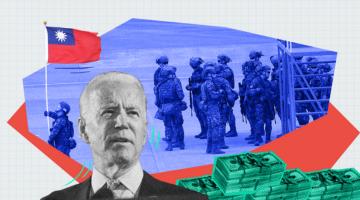The United States wants to turn Taiwan into an Asian Ukraine. The goal is to use it as a weapon against a China, a country that has been declared an adversary.
These are amended remarks given by the author at an event held by the Canadian Foreign Policy Institute titled “NATO and Global Empire.” The event can be watched in full here.
This year’s NATO Summit took place amid a geopolitical seismic wave crashing upon Eurasia: Russia’s special military operation in Ukraine. Contrary to the musings of the U.S. foreign policy establishment and its loyal servants in the West, NATO is not a defensive institution but rather the root cause of the dangerous confrontation developing between the U.S. and Russia. NATO provoked Russia to intervene in Ukraine by sponsoring a right-wing coup in 2014 and facilitating a regime of ethnic cleansing in the Donbas region for the next eight years. NATO is now prolonging the special military operation in Ukraine through massive military aid packages and economic sanctions. True to imperialism, NATO has no intention of stopping with Ukraine. The military alliance not only has plans to expand further into Eurasia to provoke Russia but also has set its sights on China in the Asia-Pacific.
NATO’s ambitions are nothing more than an extension of U.S. foreign policy objectives. The primary objective of U.S. imperialism at this moment in history is the containment of China—a euphemism for war. While U.S. Secretary of Defense Lloyd Austin has denied any intention of creating an “Asian NATO,” U.S. and NATO actions say otherwise. NATO invited Japan, Australia, New Zealand and South Korea to this year’s Summit. NATO’s so-called Strategic Concept which came out of the Summit placed heavy focus on the “threats” posed by China and went so far as to call the socialist country “malicious” in its supposed targeting of “Alliance security.”
Beyond the Summit, the United States has led the way in developing military and political alliances that mirror NATO. In 2020, the Trump administration revived the Quadrilateral Security Dialogue (known as the Quad) to bring India, Japan, and Australia further into the anti-China fold. However, members of the Quad are careful not to engage in a united military pact. The Biden administration was thus compelled to launch AUKUS in 2021, a mini-Asian NATO. AUKUS brings the United States, the United Kingdom, and Australia into a military alliance which promises to equip Australia with nuclear-powered submarines and encourage Australia to increase military spending to satisfy its imperialist partners, all in the name of countering the so-called “China threat.” On June 24th, the U.S. announced the formation of the Partners in the Blue Pacific with New Zealand, Australia, and the U.K. in an obvious response to China’s recent security agreement with the Solomon Islands.
The U.S.’s emphasis on building up military alliances in the Asia-Pacific against China can be traced back to former President Barack Obama’s Pivot to Asia strategy. The Pivot to Asia has since morphed into an “Indo-Pacific Strategy” that has garnered only lukewarm results. China’s stabilizing economic presence in the region presents a counterweight to the U.S.’s military ambitions. Even the most unfriendly nations toward China, such as Japan, must carefully negotiate between its loyalties to the U.S. and its need for trade relations with China. For all the talk of an Asian NATO or a stronger military alliance in the region, the United States has been forced up until this point to rely on bilateral relationships to forward its aggressive policy toward China.
Still, NATO’s decision to shift attention on the Pacific is a clear and present threat to world peace. Even the Washington Post-owned Foreign Policy magazine has warned of a “Global Cold War” arising out of NATO’s interest in China. The U.S. government, Northrup Grumman-funded Center for Strategic and International Studies (CSIS) has admitted that NATO is returning to a “Cold War posture.” A better term for the strategy is full-spectrum dominance. The alliances that the U.S. is attempting to build in the Pacific are nothing more than an extension of a decade-long militaristic posture toward China which has brought more than half of the U.S.’s military arsenal to the region.
This brings the question of Taiwan into view. It’s clear to anyone paying attention that the U.S. views Taiwan as the single most important flashpoint for its military strategy against China. U.S. President Joe Biden has already approved four different weapons transfers to Taiwan over the course of eighteen months. Biden has also verbalized on three different occasions that his administration is committed to defending the island from a so-called invasion from China.
These moves are dangerous violations of the status quo on the Taiwan question established during the tumultuous latter stages of the Cold War. The recognition of the People’s Republic of China by the United Nations in 1971 and the normalization of relations between the U.S. and China in 1979 affirmed Taiwan as a Chinese province under the One-China principle. However, the United States under successive administrations has moved away from the status quo by providing clear political support to separatist forces in legislation such as the Taipei Act which advocates for Taiwan’s participation within prominent international bodies. Furthermore, the United States has increased arm sales to Taiwan in violation of Article 6 of the 1982 Joint Communiqué between China and the U.S. which states:
“Having in mind the foregoing statements of both sides, the United States Government states that it does not seek to carry out a long-term policy of arms sales to Taiwan, that its arms sales to Taiwan will not exceed, either in qualitative or in quantitative terms, the level of those supplied in recent years since the establishment of diplomatic relations between the United States and China, and that it intends gradually to reduce its sale of arms to Taiwan, leading, over a period of time, to a final resolution.”
To get a picture of just how much the U.S. has violated this clause, the U.S. maintains a backlog of weapons transfers to Taiwan worth $14 billion and this number is only set to grow with the announcement of $120 million more in assistance to Taiwan’s naval forces earlier this month.
Taiwan is intimately connected to the U.S.’s overall strategy of developing a NATO-like infrastructure in the Pacific. U.S. military strategists and talking heads have become obsessed with likening Ukraine to Taiwan. Their argument is that Russia’s special military operation in Ukraine means that the U.S. must escalate in Taiwan to protect the island from China. The problem with this formulation is two-fold. Ukraine is a sovereign country. Taiwan is a province of China. Where the parallel truly resides is that similar to Ukraine being used as a pawn to forward the NATO encirclement of Russia, Taiwan is being used as a chip in the U.S.’s plans to militarily encircle China.
A key country to watch following the NATO summit is Japan. Japan’s former Prime Minister Shinzo Abe pre-empted the NATO summit by stating that China should be forced to “give up seizing Taiwan.” Japan currently stations more than 120 U.S. military bases and has already made a commitment to increase military spending in a show of loyalty to the U.S.’s anti-China geopolitical strategy. With South Korea’s election of a new pro-U.S. president and Australia’s adoption of a hostile policy toward China, the U.S. will likely seek firmer commitments from its so-called allies on the question of Taiwan.
The U.S. sees in the Taiwan question both a profitable venture for its defense industry and an opportunity to build the case for war with China. But the U.S.’s legitimacy is on the decline and China’s prestige in Asia, the Pacific, and the rest of the world is on the rise. The U.S. doesn’t merely seek alliances; it needs them. Military encirclement and the host of aggressive policies that the U.S. employs against China cannot succeed in isolation, if they can succeed at all. The U.S. understands that any conflict with China over Taiwan would require a level of support in the region similar to the servitude demonstrated by Europe against Russia.
Such a pursuit is incredibly reckless for a host of reasons. First, China presents no tangible military threat and in fact makes peace a fundamental priority in the international arena. China has only a single military base abroad and has not participated in a military conflict in more than four decades. Furthermore, while China seeks peaceful resolution to the issue of reunification with Taiwan, it will not tolerate any attempt by the U.S. to engineer independence or separatism. So-called Taiwan “independence” is China’s red-line, just as Russia’s red-line was NATO expansion into Ukraine and beyond.
The U.S.’s provocations in Taiwan thus risk a hot war with China that would inevitably lead to nuclear exchange. A hot war with China would destroy whatever stability exists around the world and create an economic and human catastrophe far greater than what has occurred over the course of Russia’s special military operation in Ukraine. Those who dismiss these real and legitimate threats to humanity in favor of Sinophobia, Yellow Peril, and New Cold War talking points are walking in lock-step with the U.S. empire. It is critical that we resist this reactionary defeatism, oppose any and all attempts of the U.S. to form a NATO-like infrastructure in the Pacific, and align ourselves with all global forces, including China, standing on the side of self-determination and peace.
Danny Haiphong’s work can be followed on Twitter @SpiritofHo and Telegram at The Haiphong Press. You can support Danny on Patreon by clicking this link. You can contact him at haiphongpress@protonmail.com.



















